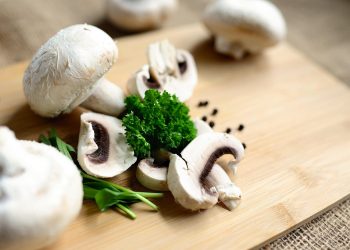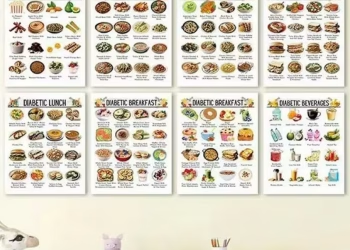Embarking on a sugar-free journey can feel daunting, but it doesn’t have to be! With a little planning and the right recipes, you can enjoy delicious and satisfying meals that nourish your body and keep your blood sugar stable. This guide provides easy-to-follow, sugar-free meal ideas that you’ll genuinely love, helping you ditch the sugar without sacrificing flavor.
Understanding the Sugar-Free Lifestyle
Before diving into recipes, it’s important to understand what a sugar-free lifestyle entails. It’s not just about avoiding table sugar. It’s about minimizing all forms of added sugar, including:
- Refined sugar: White sugar, brown sugar, corn syrup
- Natural sweeteners (in moderation): Honey, maple syrup, agave (while technically “natural,” they still impact blood sugar)
- Hidden sugars: Found in processed foods, sauces, and even seemingly healthy items like yogurt and granola bars. Always read labels carefully!
The goal is to focus on whole, unprocessed foods that are naturally low in sugar, like vegetables, fruits (in moderation), lean proteins, and healthy fats.
Breakfast: Starting Your Day Right
A sugar-free breakfast is crucial for setting the tone for the rest of the day. Avoid sugary cereals, pastries, and sweetened yogurts. Instead, opt for these delicious and healthy options:
Sugar-Free Oatmeal with Berries and Nuts
Oatmeal is a fantastic source of fiber, keeping you full and satisfied. However, traditional instant oatmeal packets are often loaded with sugar. Make your own sugar-free version:
- Ingredients: ½ cup rolled oats, 1 cup unsweetened almond milk (or water), ¼ cup mixed berries (blueberries, raspberries, strawberries), 1 tablespoon chopped nuts (almonds, walnuts), sprinkle of cinnamon.
- Instructions: Combine oats and almond milk in a saucepan. Bring to a boil, then reduce heat and simmer for 5-7 minutes, or until oats are cooked through. Top with berries, nuts, and cinnamon.
Scrambled Eggs with Spinach and Avocado
A protein-packed breakfast is always a winner. This recipe is quick, easy, and full of healthy fats.
- Ingredients: 2 eggs, 1 cup spinach, ¼ avocado, salt and pepper to taste, olive oil.
- Instructions: Heat a small amount of olive oil in a pan. Sauté spinach until wilted. Whisk eggs with salt and pepper. Pour eggs into the pan and scramble until cooked through. Serve with sliced avocado.
Sugar-Free Greek Yogurt with Seeds and a Few Berries
Look for plain, unsweetened Greek yogurt, which is high in protein and low in sugar. Add some healthy fats and a touch of natural sweetness:
- Ingredients: 1 cup plain, unsweetened Greek yogurt, 1 tablespoon chia seeds or flax seeds, ¼ cup berries (choose lower-sugar options like raspberries), optional: a few drops of liquid stevia.
- Instructions: Combine all ingredients in a bowl and enjoy.
Lunch: Fueling Your Afternoon
Lunch should provide sustained energy to power you through the afternoon. Avoid processed lunch meats, sugary dressings, and white bread.
Tuna Salad Lettuce Wraps
A healthy and refreshing alternative to traditional tuna salad sandwiches.
- Ingredients: 1 can tuna in water (drained), 2 tablespoons mayonnaise (choose avocado oil mayo for a healthier option), 1 tablespoon chopped celery, 1 tablespoon chopped red onion, lettuce leaves (romaine or butter lettuce).
- Instructions: Combine tuna, mayonnaise, celery, and red onion in a bowl. Mix well. Spoon tuna salad into lettuce leaves and serve.
Chicken Caesar Salad (Sugar-Free Dressing)
Caesar salad can be healthy, but the dressing is often loaded with sugar. Make your own sugar-free version:
- Ingredients: Grilled chicken breast (sliced), romaine lettuce, parmesan cheese, sugar-free Caesar dressing (recipe below).
- Sugar-Free Caesar Dressing: Combine ¼ cup mayonnaise (avocado oil), 2 tablespoons olive oil, 1 tablespoon lemon juice, 1 teaspoon Dijon mustard, 1 clove garlic (minced), salt and pepper to taste.
- Instructions: Combine romaine lettuce, chicken, and parmesan cheese in a bowl. Drizzle with sugar-free Caesar dressing.
Leftover Dinner
Don’t underestimate the power of leftovers! Packing a portion of your sugar-free dinner for lunch is a convenient and healthy option.
Dinner: Satisfying and Sugar-Free
Dinner is a great opportunity to load up on vegetables, lean protein, and healthy fats.
Baked Salmon with Roasted Vegetables
A classic and nutritious meal that’s easy to prepare.
- Ingredients: Salmon fillets, broccoli, bell peppers, zucchini, olive oil, salt, pepper, garlic powder.
- Instructions: Preheat oven to 400°F (200°C). Chop vegetables into bite-sized pieces. Toss vegetables with olive oil, salt, pepper, and garlic powder. Spread vegetables on a baking sheet. Place salmon fillets on a separate baking sheet. Drizzle salmon with olive oil, salt, and pepper. Bake for 15-20 minutes, or until salmon is cooked through and vegetables are tender.
Chicken Stir-Fry with Cauliflower Rice
A quick and easy meal that’s packed with flavor. Use coconut aminos instead of soy sauce to keep it sugar-free.
- Ingredients: Chicken breast (cubed), broccoli florets, bell peppers (sliced), carrots (sliced), cauliflower rice, coconut aminos, ginger (grated), garlic (minced), sesame oil.
- Instructions: Heat sesame oil in a wok or large skillet. Add chicken and cook until browned. Add broccoli, bell peppers, and carrots and stir-fry until tender-crisp. Add cauliflower rice, coconut aminos, ginger, and garlic. Stir-fry until heated through.
Lentil Soup
A hearty and filling vegetarian option that’s perfect for a cold day.
- Ingredients: Lentils, vegetable broth, diced tomatoes, carrots (diced), celery (diced), onion (diced), garlic (minced), olive oil, cumin, turmeric, salt, pepper.
- Instructions: Heat olive oil in a large pot. Add onion, carrots, and celery and sauté until softened. Add garlic and sauté for another minute. Add lentils, vegetable broth, diced tomatoes, cumin, turmeric, salt, and pepper. Bring to a boil, then reduce heat and simmer for 30-40 minutes, or until lentils are tender.
Snacks: Curbing Cravings the Sugar-Free Way
Snacking smartly is key to maintaining a sugar-free lifestyle. Avoid processed snacks like cookies, candy, and chips. Instead, reach for these healthy options:
- Nuts and seeds: Almonds, walnuts, pumpkin seeds, sunflower seeds
- Vegetables with hummus: Carrots, celery, bell peppers, cucumbers
- Hard-boiled eggs: A great source of protein
- Cheese sticks: Choose low-fat options
- Avocado: A healthy and satisfying snack
- Small handful of berries: Raspberries, blueberries, strawberries
Tips for Success on a Sugar-Free Diet
Following a sugar-free diet requires commitment and planning. Here are some tips to help you succeed:
- Read food labels carefully: Pay attention to serving sizes and sugar content. Look for hidden sugars like high fructose corn syrup, dextrose, and maltose.
- Plan your meals in advance: This will help you avoid impulsive decisions and unhealthy choices.
- Cook at home more often: This gives you control over the ingredients and portion sizes.
- Stay hydrated: Drink plenty of water throughout the day.
- Find healthy substitutes for your favorite sugary foods: Experiment with sugar-free sweeteners like stevia or erythritol in moderation.
- Be patient with yourself: It takes time to adjust to a sugar-free lifestyle. Don’t get discouraged if you slip up occasionally. Just get back on track as soon as possible.
- Focus on whole, unprocessed foods: These foods are naturally low in sugar and packed with nutrients.
Conclusion
Adopting a sugar-free lifestyle is a journey towards better health and well-being. By incorporating these easy and delicious recipes into your diet, you can enjoy satisfying meals while minimizing your sugar intake. Remember to read labels carefully, plan your meals, and be patient with yourself. With commitment and consistency, you can successfully embrace a sugar-free life and reap the many benefits it offers.
Frequently Asked Questions (FAQs)
What are the benefits of a sugar-free diet?
A sugar-free diet can offer numerous health benefits, including weight loss, improved blood sugar control, reduced risk of type 2 diabetes, increased energy levels, clearer skin, and improved mood.
Is a sugar-free diet the same as a no-carb diet?
No, a sugar-free diet focuses on eliminating added sugars, while a no-carb or low-carb diet restricts overall carbohydrate intake. You can follow a sugar-free diet while still consuming healthy carbohydrates from fruits, vegetables, and whole grains (in moderation, depending on your specific needs).
What are some natural sugar substitutes I can use?
Some natural sugar substitutes include stevia, erythritol, monk fruit, and yacon syrup. However, it’s important to use these in moderation, as they can still affect blood sugar levels in some individuals.
Is fruit allowed on a sugar-free diet?
Yes, fruit is allowed in moderation on a sugar-free diet. Choose lower-sugar fruits like berries, grapefruit, and green apples. Be mindful of portion sizes and avoid fruit juices, which are often high in sugar.
What do I do when I have sugar cravings?
When sugar cravings hit, try drinking a glass of water, going for a walk, or having a healthy snack like nuts or vegetables with hummus. Sometimes cravings are simply a sign of dehydration or nutrient deficiency.
How long does it take to adjust to a sugar-free diet?
The adjustment period varies from person to person. Some people may experience withdrawal symptoms like headaches or fatigue in the first few days, but these usually subside within a week or two. Be patient with yourself and stay committed to your goals.
Can I still eat out on a sugar-free diet?
Yes, you can still eat out, but it requires careful planning and smart choices. Choose restaurants that offer healthy options and ask for modifications to your meals, such as no added sugar in sauces or dressings. Be sure to read the menu carefully and ask your server about the ingredients.
Is a sugar-free diet safe for everyone?
While a sugar-free diet is generally safe for most people, it’s always a good idea to consult with a doctor or registered dietitian before making significant changes to your diet, especially if you have any underlying health conditions or are taking medication. This is particularly important for individuals with diabetes or those who are pregnant or breastfeeding.












